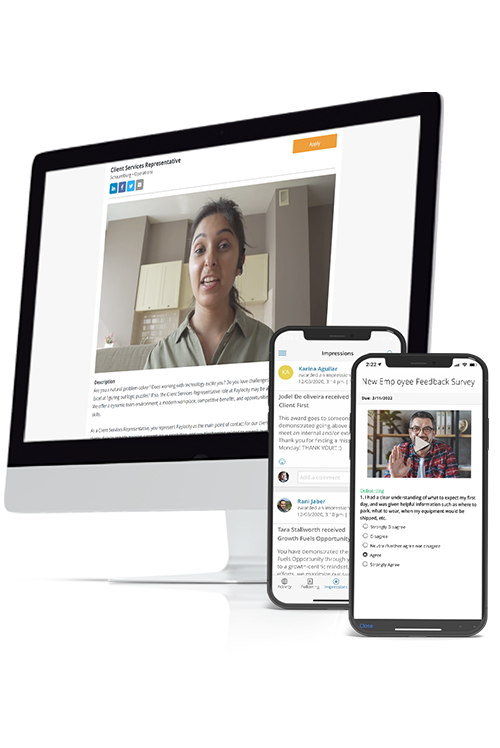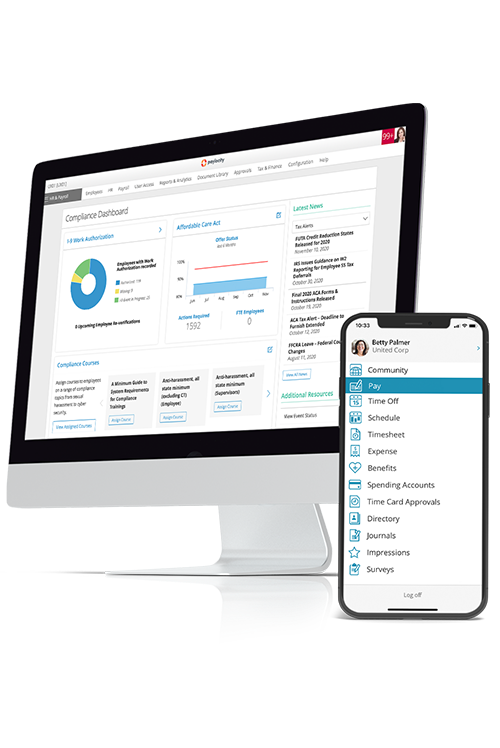resources
How to Maximize Your Multigenerational Workforce
July 28, 2023
With today’s workforce spanning multiple, technologically disparate generations, companies must look at ways to ensure all employees feel productive and considered.
Blog Post

Skip to end of table of contents
Table of Contents
The modern workforce is more multigenerational than ever before.
Young Generation Z workers are now integrating with Millennials, Generation X, and even Baby Boomers, who are staying in the workforce longer than generations before.
Such disparate age groups rubbing shoulders in the same office (virtual or otherwise) comes with its share of challenges — technological, cultural, and beyond.
But within these challenges lies opportunity to leverage the advantages of youth with the experience of the aged, achieving a "golden mean" of mature innovation.
In this article, we'll delve into the dynamics of today's multigenerational workforce, uncovering challenges, opportunities, and discussing ways to bridge the gap for harmonious business success.
What is a Multigenerational Workforce?
A multigenerational workforce is a group of colleagues or employees for the same company that come from different generational backgrounds.
Today’s workforce is largely made up of four different generations:
- Baby Boomers (1946-1964)
- Generation X (1965-1980)
- Millennials or Generation Y (1981-1996)
- Generation Z (1997-2012)
The big difference between the generations, aside from the ages of their members, is the global environment in which they grew up. On one end of the spectrum, Baby Boomers grew up in the immediate post-World War II era. And the youngest of the workforce, Gen Z, were born into a digital and inter-connected world.
There has been immense cultural transformation between these two eras, and these kinds of societal differences had a huge impact on these generations and their ways of thinking.
Multigenerational workforces must bridge the gaps between everyone’s experiences and create an environment where people born anytime between 1946 and 2012 can flourish.
The Benefits of a Multigenerational Workforce
What makes working across generations so valuable, exactly?
Well, let’s look at some of the most notable benefits of a multigenerational workforce and why it’s a great idea to make sure your workplace so inclusive:
Better Problem Solving
Keep presenting a problem to the same type of person, and you'll keep getting the same kind of solution.
This can be a good thing when the problem in question is minor or unremarkable. But what about more important issues? It’s limiting to rely on the same type of answer anytime something comes up.
This is where multigenerational leadership and teamwork can shine.
Multigenerational teams can use their inherent diversity to come up with many different potential solutions to any given problem. That means introducing more creativity into the problem-solving process and ensuring your company stays open to varying voices and approaches.
Different Perspectives
Like spending Thanksgiving with the extended family, a multigenerational workforce comes with plenty of different opinions, viewpoints, and perspectives.
While there's potential there for conflict, having a good mix of perspectives can also help you reach balanced conclusions if handled respectfully.
Incorporating different perspectives also keep your company fresh and relevant. If you limit your workforce to just one or two generations, you’ll shut out whole groups of talent and thought, which may lead to stagnation.
Learning Opportunities and Mentoring
Gen Z: Social media pros, tech-savvy, and quick learners – ideal mentors for older colleagues.
Baby Boomers and Gen X: Seasoned pros with invaluable work experience, primed for mentorship to pass down their expertise.
Caricatures aside, the point is that each generation brings unique strengths to the table. Fostering an open-minded office culture that encourages multigenerational interactions maximizes the synergy of these mixed perspectives.
Multigenerational Workforce Challenges: What to Look Out For
Of course, it’s not all sunshine and rainbows in a multi-gen workforce. There are cultural landmines aplenty human resources must be prepared to address. We'll tackle a few.
Negative Stereotypes and Assumptions
If you ask someone in HR, “What is a major challenge related to working across generations?”, assumptions and stereotypes is a likely first answer.
In fact, you’ve likely heard a few of them yourself:
- “Millennials are lazy and don’t want to apply themselves.”
- “Baby Boomers are out of touch and backward-thinking.”
- “Gen Z doesn’t have any company loyalty and will walk out at the drop of a hat.”
- “Gen X is cynical and apathetic.”
These kinds of statements are a barrier to effective teamwork.
If your Gen X hires have to spend half their time just trying to convince people that they do care and are not killjoy cynics, then half their efforts are wasted on a stereotype that has no place in a work setting.
Leaders in particular must address and debunk generational stereotypes, stressing their harmful impact, both to the workers and the business. Instead, cultivate open-mindedness, emphasizing human connections beyond generational labels.
Communication Issues
What does “👍” mean to you?
This simple thumbs up can have a drastically different meaning depending on when you were born and how you were socialized. Where a Baby Boomer or Gen X-er might use this to mean “roger that” or “I agree,” Millennials or Gen Z-ers may interpret it as passive aggressive or apathetic.
As you can imagine, this leads to communication issues.
To overcome this challenge, emphasize open communication as part of your company culture. Encourage questions. Discourage defensiveness. Invite clarity if workers are rubbed wrong by a message — it may just be a miscommunication.
Tribalism and Different Work Styles
Amidst diverse work styles, the multigenerational workplace harbors the danger of in-groups and tribalist tendencies. Employees may naturally seek solace among same-aged colleagues as a defense mechanism against the perceived "others."
While natural, this behavior is destructive to the workforce. Companies must fight against the formation of exclusive tribes that alienate significant portions of the workforce — unintentionally or otherwise.
Try organizing cross-generational team-building activities, workshops, and mentorship programs. Encourage employees to inspire each other and always stay open to learning new things.
Best Practices for Managing a Multigenerational Workforce: How to Bridge the Gap
We’ve already briefly touched on how you can address some of the most prominent barriers to managing generational differences in the workplace effectively. But what about best practices that let you do more than just patch holes in the boat?
Adopt a Flexible Approach
When managing different generations in the workplace, be as flexible as you can.
Being completely rigid means that only one type of individual can feel at home, and that usually means shutting out whole generations just because they don’t fit a particular mold.
Workplace flexibility can take a variety of forms, such as:
- Remote or hybrid workplaces
- Flexible scheduling or easy shift swapping
- Open and varied workspaces
- Varying communication styles
Keep these in mind when creating organizational policies to accommodate the different preferences of your workforce.
Get to Know Your Team as Individuals
Managing across generations shouldn’t mean treating everyone just according to their age group. Remember, they’re individuals first.
Creating community in the workplace is much easier when you accept this.
Your team is its own micro-community, and it’s going to consist of different people with different ideas, values, mindsets, and upbringings. Focus on creating workplace connections that bridge generational divides.
This is easier when you use a digital social collaboration hub to facilitate communication. Use these types of platforms to create cross-departmental groups centered around hobbies and interests. Make sure you use the hub to share moments that matter and celebrate personal and professional wins with the broader team.
All of these tactics make it easier for your employees to get to know one another as individuals.
Encourage Learning and Mentoring
Everyone can learn from one another, but this doesn’t always happen on its own. Often you have to intentionally create the space for it to occur.
One way you can encourage intergenerational learning (and any other kind of learning) is with a learning management system that allows you to house a robust library of custom learning content.
These systems let your employees record videos of themselves, then share those videos within the system for their colleagues to see. Paylocity's Community tool even provides a social media-like experience for people to react and comment to this content.
Embrace Generational Diversity and Create an Inclusive Work Environment
Like all forms of diversity, generational diversity has the potential to massively improve your workplace if managed intentionally. When people of all ages come together to work as a unit, you can reach heights no one group could attain on its own.
But, the right tools are essential when it comes to managing a diverse workforce.
Paylocity’s HR and Payroll software is equipped with a full suite of communication tools that make it easier to manage a multigenerational workforce. Designed with the user in mind, Paylocity connects employees through chat, discussion groups, announcements, video, peer recognition, mentoring tools, a learning library, and more.
Request a demo today to see how Paylocity can help you manage your multigenerational workforce.




